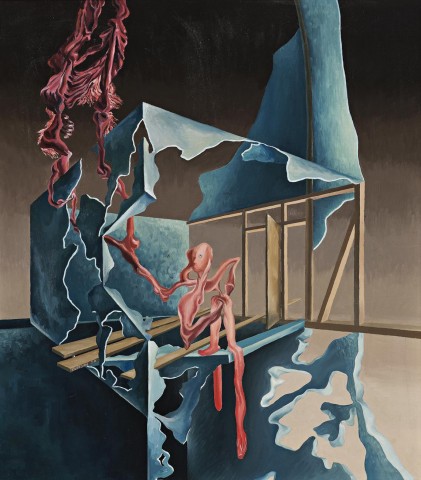FILIGREE, 1939
JAMES GLEESON
oil on canvas
72.5 x 63.5 cm
signed and dated lower left: Gleeson 39
inscribed with title on frame verso: Filigree
Private collection
Leonard Joel, Melbourne, 2 November 1977, lot 1247
Private collection, Melbourne
Thence by descent
Private collection, Melbourne
James Gleeson was Australia’s most sustained and committed surrealist artist and this remarkable painting dates from the earliest years of his career. It has rarely been seen in public since. In 1939, when Filigree was painted, Gleeson submitted eleven paintings to the second Teachers’ Federation Art Society Annual Exhibition in Sydney. One of his co-exhibitors (with six paintings) was the future art historian Bernard Smith, who recognised that this combined outing ‘was the largest number of surrealist works that had been shown publicly in Sydney up to that time’.1 Although Filigree, 1939 was not included in that show, it is a fascinating record in itself of the influences being rapidly absorbed and personalised by the young artist.
The late 1930s were increasingly troubled times with the inexorable climb of Fascism as the Spanish Civil War raged. It was ‘a time of fear, anxiety, and the coming to a crossroads where taking one path instead of another could mean death and loss of integrity’.2 In Sydney, as in Melbourne, political debates raged within the artistic community and would lead to serious divisions over the following years. However, Bernard Smith, who met Gleeson in January 1939, recognised that Gleeson’s interest in surrealism was not political; rather, ‘It was the intuitive, unpolitical (sic) side of the movement that attracted him: Freud and Dali’.3 Formally conceptualised in 1924 in Paris by Andre Breton, the surrealist movement understood that ‘the flint that supplies the magic spark of true creative thought is always found in the more unruly regions of the mind … in the minds of all Surrealists, true creativity, this unique and precious human attribute, has something untamed about it’.4 Gleeson already owned a copy of Dali’s rare publication Conquest of the Irrational (1935) and whilst there are definite echoes of the Spanish painter’s imagery in Gleeson’s early paintings, other strong stimuli came from artists such as Andre Masson and Yves Tanguy. Gleeson was also looking after a 1925 painting by Giorgio de Chirico whilst its owner was overseas, and elements of all these artists come together in his early paintings.
Filigree is like a moment of frozen entropy, held firm by the artist’s brush. There is a palpable feeling that the ribbon-like figure will soon drip from the scaffolding as the building decays around it. There can be no literal interpretation for the scene – it is what it is – and no doubt relates deeply to Gleeson’s personal exploration of the subconscious. In a poem-drawing from that same year, Gleeson wrote: ‘I have shown my breast dutifully in the house/ for the familiar things to see it. They have been afraid/ of the eye that weeps in my breast’.5 Dreamlike and esoteric, these words could also be applied to the imagery found in Filigree, September 1939, Gleeson presented a talk at the Teachers’ Federation exhibition entitled ‘What is Surrealist Art?’ and in it, he questioned whether surrealism was to be ‘a fleeting transition or the beginning of a new movement.’ With a notable career that was to span the next seventy years, it would seem that Gleeson was able to provide his own answer, a resounding ‘yes!’ to its longevity.
1. Smith, B., The Boy Adeodatus: the portrait of a lucky young bastard, Allen Lane, Victoria,1984, p. 281
2. Free, R., James Gleeson: Images from the shadows, Craftsman House, Sydney 1993 (1996), p. 11
3. Smith, B., op. cit., p. 258
4. Wach, K., ‘James Gleeson and Surrealism: The Inexhaustible Murmur’, in Klepac, L., James Gleeson: Beyond the screen of sight, The Beagle Press, Sydney, 2005, pp. 24 – 25
5. On the Destruction of the Face as Authentic Phenomenon, 1939, in the collection of National Gallery of Australia, Canberra, reproduced in Gleeson, J., Selected Poems, Angus and Robertson, Sydney, 1993, p. 26
ANDREW GAYNOR
